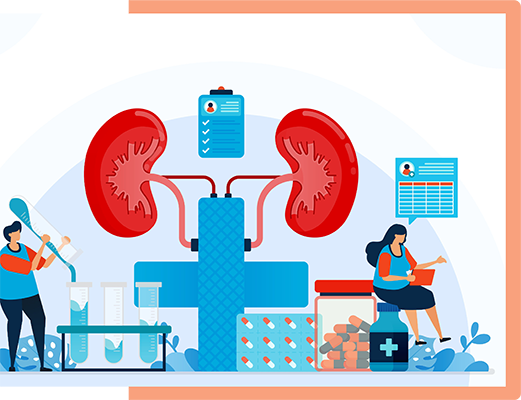

Kidney cancer, as the name suggests, starts in our kidneys. It is a highly contagious cancer form. Cancer spreads across the body from the kidney. Our kidneys are bean-shaped and are found on either side of the lower abdomen. They are fist-sized organs. Each side of the spine comprises one kidney, behind the abdominal organs. The most prevalent and widespread cancer among adults is renal cell cancer. Yet, there are several other forms of cancer found among adults. Young children are more prone to Wilms’ tumor which is another kidney cancer type.
Kidney cancer is becoming more and more common in India. It is considered to be among the top ten cancer types prevalent in India. The lifetime risk among men is around 2.02 percent or one in 46. On the other hand, lifestyle risk among women is around one in 80 cases.
Medica’s oncology department specializes in globally recognized cancer treatment facilities. This is possible with our combined expertise spanning more than three decades. We have world-class Onco-surgeons and oncologists supported by the latest equipment and technologies in cancer treatment. This department is further supported by highly skilled and experienced reconstructive surgeons. Together, we boast extensive and world-class treatment for our patients, adults & children likewise.

Kidney cancers are of various types. Understanding the cancer type is a critical factor in determining diagnosis and treatment. Some of the common kidney cancer types are renal cells, transitional cells, and Wilms’ tumor. It is important to collaborate with the healthcare provider closely. This will help discover the kidney cancer type and the diagnosis. It will also help select the treatment strategy appropriate for the cancer type. It will also help select treatment preferences.
Renal Cell Cancer: This is the most prevalent and frequent kidney cancer type. The tumor cells are found in the inner lining of kidney cells. These are small tubes found in our kidneys. The tumor cells transform into bulk and create significant blockage after some time. This cancer can develop in a single kidney or both.
Wilms Tumor: This type of tumor is more common among children compared to adults. As such, the treatment is also different. Around one percent of all malignancies related to the kidney are Wilms’ tumors. Surgical treatment of this tumor type is more successful when paired with chemotherapy and radiation therapy. This treatment strategy is an emerging method for treating cancer.
Urothelial Carcinoma: It is also called transitional cell cancer. Around 5-10 percent of all cancer malignancies in adulthood are transitional cells. The tumor starts from our renal pelvis. It is the kidney part where urine is stored. From there the urine enters the bladder. The treatment for this kidney cancer type is similar to that of bladder cancer. This is because both cancer types start in the internal lining of the bladder and renal pelvis.
Sarcoma: This is a rare and uncommon type of kidney cancer. It occurs within the soft tissues of the kidney. It is a capsule comprising of a thin connective tissue layer surrounding the kidney. Renal sarcoma is usually treated through surgery. However, the sarcoma can recur frequently, and return in one or both kidneys. It can also spread across other body parts. After the initial surgery, the patient may need further chemotherapy or surgery.
Lymphoma: This cancer enlarges both our kidneys. It is also associated with lymphadenopathy or enlarged lymph nodes. These enlarged nodes can be found in other body regions such as the chest, neck, or abdomen. Lymphoma often presents itself as one single mass of tumor in our kidneys. However, enlargement of lymph nodes is rare in this type of cancer. If a lymphoma is suspected, the doctor may recommend biopsy and chemotherapy rather than surgery.
Signs and symptoms are almost invisible during the early kidney cancer stages. Symptoms appear only in the later stages. Some of these symptoms are:

The underlying cause of kidney malignancies is still largely unknown. According to experts kidney cancer occurs due to mutation of the cell DNA of the kidneys. This mutation forces the aberrant cells to replicate and expand. The expanded cells then clump together and result in kidney tumors. This tumor grows in size and also breaks off to other body parts, resulting in metastasis.
Additional Risk Factors
Age: The chances of getting a kidney tumor increases with age.
Family History: Chances of getting kidney cancer increase if any immediate member of the family has this disease.
Genetic Disorders: Some genetic disorders increase the risk associated with kidney cancer. These include individuals with Birt-Hogg-Dube syndrome, Hippel-Lindau disease, tuberous sclerosis, or papillary renal carcinoma.
Hypertension: Those with hypertension or high BP are more prone to kidney cancer
Obesity: Overweight and obese people have higher chances of developing kidney cancer compared to people who have a healthy or lean weight.
Smoking: Smoking enhances the risk of developing kidney cancer. This risk, however, reduces significantly once you stop smoking.
Kidney Failure Treatments: Those with long-term dialysis or treatments for kidney diseases or chronic failure are more prone to kidney cancer.
Kidney cancer can be categorized into several stages. This categorization helps in determining the diagnosis and treatment type. There are four main stages of kidney cancer. These are:
Stage I: This is the first stage or primary stage of kidney cancer. The diameter of the tumor in this stage is around seven centimeters. The tumor is concentrated in one region. It is yet to reach our lymph nodes or other organs in this stage.
Stage II: This is the second stage of kidney cancer. The diameter of the tumor increases to more than 7 centimeters in this stage. The organs and lymph nodes are safe in this stage.
Stage III: This is an advanced stage of kidney cancer. The stage is identified by several tumor sites and tumor sizes. The kidney tumor can be of any size in this staqe. It reaches a major arterial vein like the vena cava or renal vein. It can also spread to the tissues or surrounding kidney area along with the adjacent lymph nodes.
Stage IV: It is the most advanced stage of kidney cancer. Just like the last stage, it is also defined by different sites and sizes of the tumor. Irrespective of the size, the tumor can spread to adjoining lymph nodes and other body parts. The tumor may reach the adjacent adrenal gland, lying above the kidney.
Several methods and tests are conducted for diagnosing kidney cancer. These can be:
Urine & blood tests: Urine & blood tests are used for identifying the underlying causes behind the symptoms and sizes.
Imaging Tests: These tests help doctors in identifying abnormalities or tumor in our kidneys. Some of the common imaging tests are CT scan, MRI scan, X-ray, and ultrasound.
Biopsy: Biopsy involves taking a tissue sample from the kidney. The tissue sample is extracted from the tumor spot and sent to a laboratory. Here the sample is evaluated for any malignancy. Doctors can also skip this step if the cancer is already detected and diagnosed.
Treatment varies based on tumor size, type, formation, patient health, and preferences. Surgery is a preferred treatment when malignancies are clearly visible. If the tumor has progressed, the doctor may recommend additional treatments. These can be a combination of surgery and non-surgical treatments. Available surgical remedy can be nephrectomy for Kidney cancer.
At Medica, the treatment team is always ready to listen to their patients. The options for kidney therapy are decided together with the patients. Optimal treatment will include evaluation of patient health, kidney cancer type, size, and spread as well as treatment preferences.
Non-Surgical Options
Doctors often recommend non-surgical options in certain cases. These treatments like ice and heat can be used to destroy smaller malignancies. Some people with health issues cannot undergo surgery for kidney cancer. For them, non-surgical options are recommended. Some of these possibilities are:
Cryoablation: This process uses ultrasound and similar imaging guidance. A hollow needle of unique nature is penetrated into the skin. It reaches kidney cancer during the cryoablation process. The needle exerts cold gas which freezes these cancer cells.
Radiofrequency Ablation: In this process, ultrasound imaging is used as a unique probe. This probe is put into the skin and then into the tumor. The probe releases an electrical current through a needle. This current destroys the tumor cells by burning them or heating them.
In case cancer has spread across other body parts, progressed to a significant size, or has become recurrent, there are separate treatments suggested by the doctor. These treatments can include:
Targeted Therapy: In this therapy targeted medication is used. These medications target specific tumor cells in the kidney. The therapy involves killing these tumor cells by inhibiting the aberrations. It is best to test the type of cancer cells so that the most effective targeted drugs are used.
Immunotherapy: This cancer therapy uses our immune system to target the tumor cells. Cancer cells have proteins assisting them to hide from our immune cells. This results in the immune system not being able to attack the cancer cells. In immunotherapy, the immune system is enhanced with drugs. This helps our immune system automatically identify and attack cancer cells.
Radiation Therapy: In radiation therapy, high-powered radiation beams are used. These beams can come from sources like protons or X-rays. This therapy is used when cancer progresses to other body parts like the brain or the bones.
Happy Clients
Recovery
Expert Doctors
Award